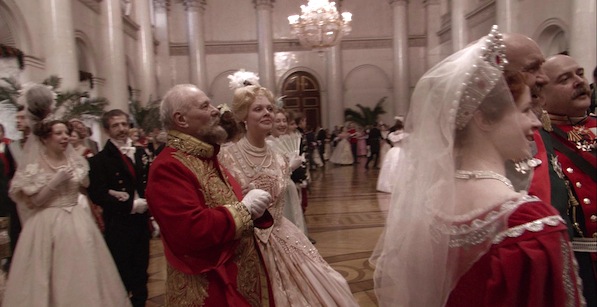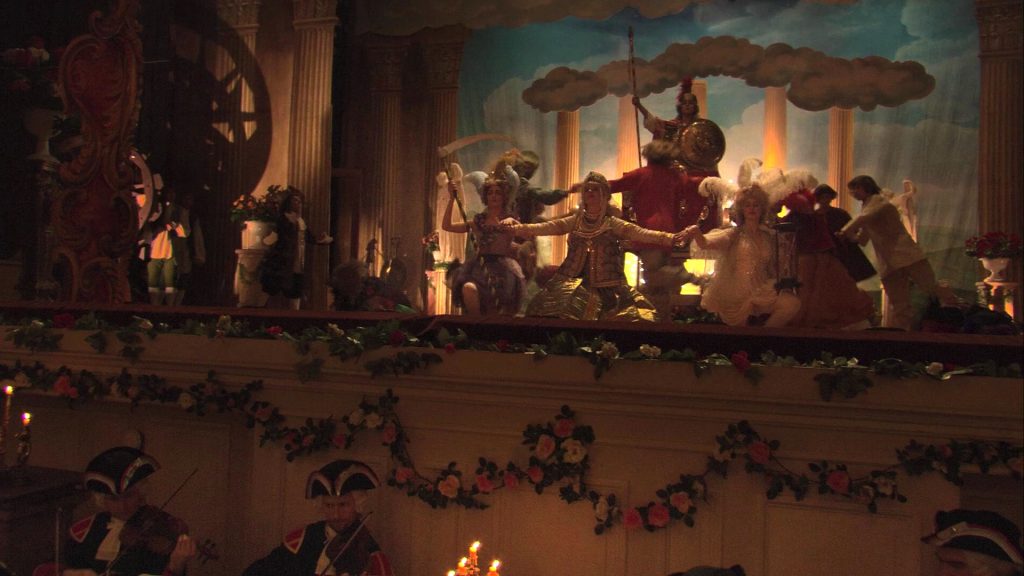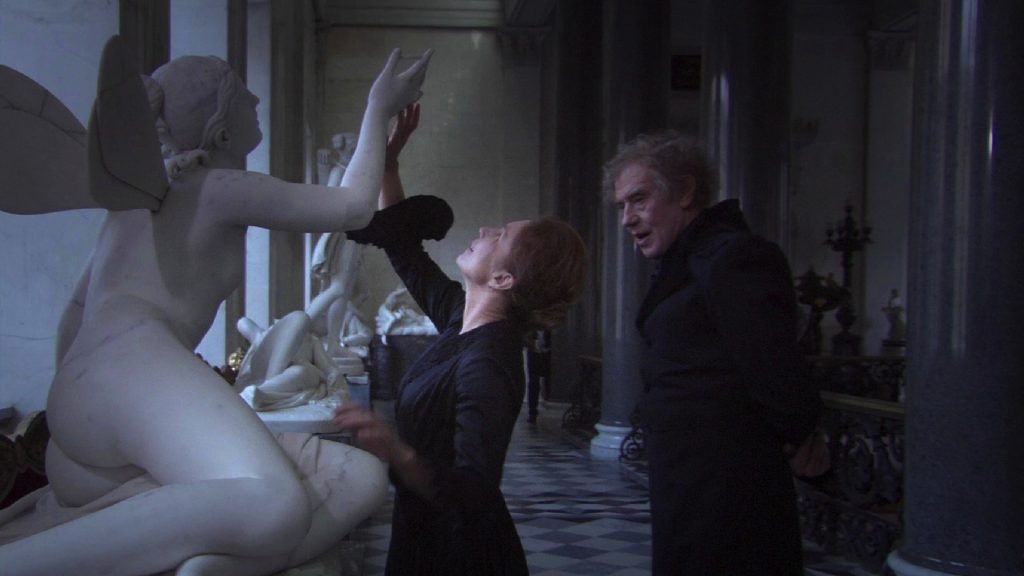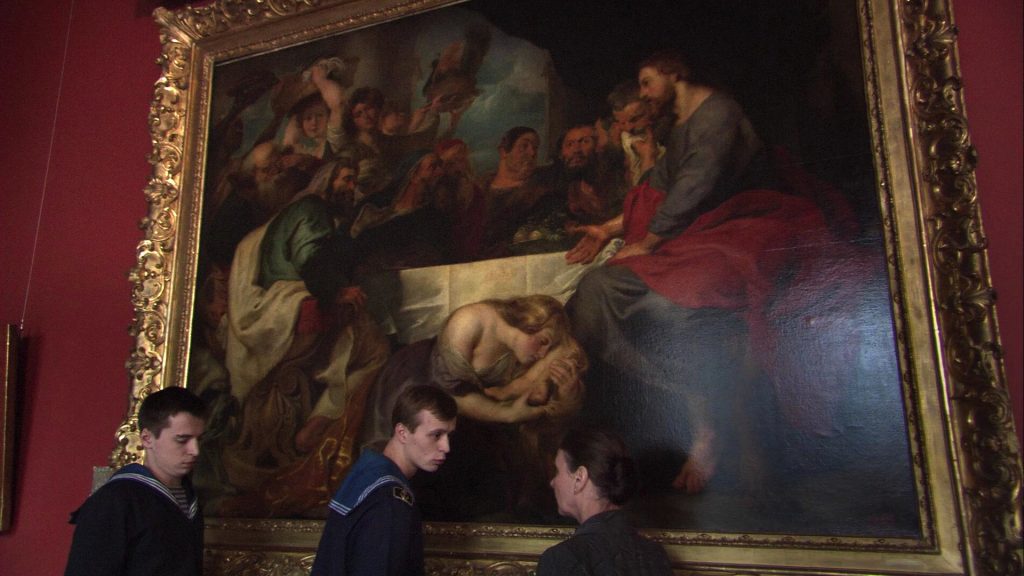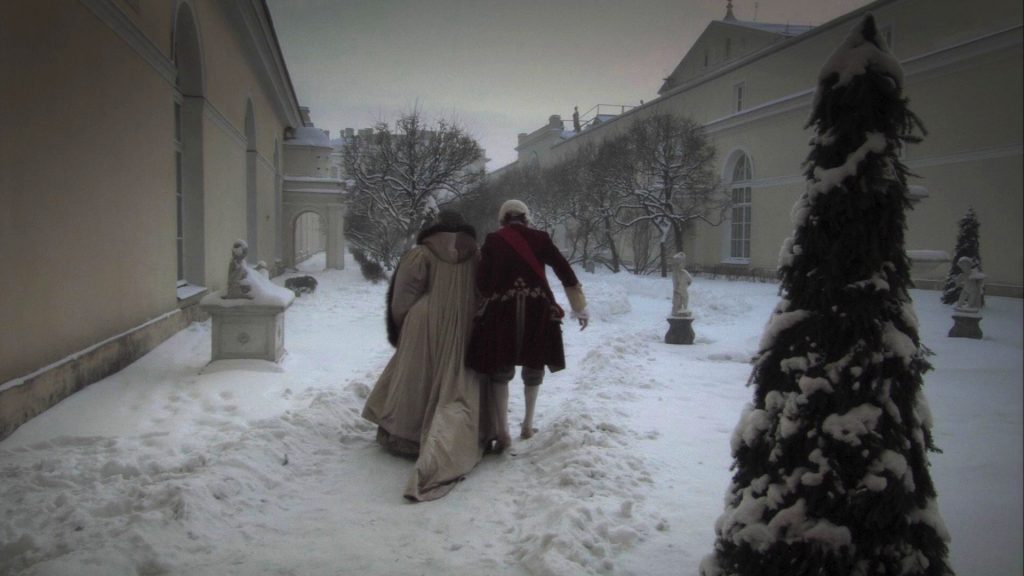Alexander Sokurov’s tribute to the State Hermitage Museum of Saint Petersburg, a tour through time and space created in a single, unbroken shot lasting over ninety minutes, is a cinematic experience like no other. Neither documentary nor traditional narrative, it is sui generis, marrying history and art in a tour-de-force act of filmmaking that is as graceful as a ballet and as thoughtful as an essay.
The camera floats through the rooms and hallways and crowds like the disembodied spirit of our mysterious narrator (voiced in the intimate rumble of an interior monologue by the director himself), at times guided by an eccentric host identified in the credits only as “the Stranger,” a spindly, aristocratic time traveler who slips back and forth through history and seems at home in every era. Crossing the threshold to each gallery is like stepping into another era, from the modern museum teeming with contemporary patrons to an 18th-century reception when it was the Winter Palace of the Tsar to a storeroom filled coffins for the dead of World War I to the reverie of the last royal ball of 1913. It’s a dance through history and Sokurov is the master choreographer.
Russian Ark is also a technical achievement without parallel. Filmmakers have long found ways to create the illusion of continuous fluid action, from invisible cuts to optical tricks to CGI sutures. Sokurov resorts to no such devices. Russian Ark is the first full-length, single-screen feature film shot in a single, unedited take; the longest sustained SteadiCam sequence ever executed in a film; and the first uncompressed High Definition digital movie recorded to a hard disc. The Hermitage closed its doors to visitors on December 23, 2001, to give Sokurov and his team full access to the facility. They had a single day in the depths of the Russian winter to put all the pieces together in a single, seamless take. That day was four years in the making.
The project was initiated by the directors of the Hermitage itself, who wanted to showcase the museum on film. It was Sokurov, approached by the producers in the late 1990s, who came up with the idea of shooting in a single, unbroken take on digital cameras: “To make a film in one breath,” as he put it. He couldn’t lay track, so it needed to be completely handheld and he found his cinematographer in Tillman Büttner, a German Steadicam operator who had photographed (among many other projects) the impressive handheld scenes of Run Lola Run. Together they mapped out a route through the Hermitage that measured almost a mile long, taking the camera out of the controlled conditions of the Hermitage and into the freezing temperatures of the courtyard (Büttner tested lenses to find one that wouldn’t fog up in the transition). They knew that they would need to shoot in high definition digital but in 1999, during the planning phase, the technology to record ninety minutes of 35mm-quality footage to a single drive, the minimum technical requirement for Sokurov’s proposal, was not there yet. Büttner continued searching during preproduction and found his answer in a Sony system that recorded uncompressed HD images directly onto a one terabyte hard disk. The entire outfit weighed almost eighty pounds, which Büttner alone carried on his shoulders in a Steadicam system he custom built to accommodate the new technology. “Because of my physical endurance, I could only do one take,” he told Indiewire in 2002.
Sokurov scripted scenes for every room along the journey, from historical recreations to aesthetic communion: a blind woman approaching sexual ecstasy while taking in the tactile pleasures of a statue, another woman dancing while communing with a painting, our guide sniffing the oils from a canvas as if sampling a buffet. There are intimated moments and epic scenes and a finale that recreates a royal ball with hundreds of dancers and a full symphony orchestra, a scene suffused with a luxurious nostalgia that is as poignant as it is ambiguous. All told there are over 180 actors and 1,300 extras, all of whom had to perform on cue without a slip, with more than twenty assistant directors managing the locations, preparing the actors, and communicating with the camera team, and an enormous camera and lighting team.
And there were restrictions imposed by the location. The Hermitage, a busy, bustling museum, could only be closed to the public for a single day of shooting. No actual historical items could touched by the actors or the crew (props were substituted for dramatic scenes). The camera operators could go no closer than two meters from the objects on display. Sets had to be built and rooms dressed to transform galleries and other contemporary spaces into salons and ballrooms and workrooms from the recent and the distant past. And the entire route needed to be lit with lights that could either be hidden from the camera or physically moved by the crew as the camera made its journey.
The cast and crew spent weeks planning and prepping the shoot, with individual scenes and transitions rehearsed in advance, but that all took place in off-site rehearsal spaces and there was no opportunity for a full dress rehearsal in the Hermitage itself. Büttner walked the entire route only five times before the day of shooting and the team had only twenty-six hours to redress and light each of the thirty-three rooms featured in the film before shoot commenced. Everything had to work in concert on the day of production, with Sokurov directing actors while communicating with the crew and coordinating the entire endeavor: director, project manager, and circus ringmaster all in one. Just to complicate it all, Sokurov spoke no German and Büttner didn’t speak Russian so a translator played go-between during the shoot. Sound was added later out of necessity. As Büttner confessed, “Every time I did the take, or someone else made a mistake, I would curse, and that would have gotten in.”
At 12:30 pm on December 23, 2001, the first take began. They had a four-hour window, thanks to the limited hours of sunlight in the St. Petersburg winter, and essentially one shot at a full take. There would be no time to reset the lights and sets and actors after a certain point. The first three attempts were cut short by technical difficulties, all caught early in the process, and the entire production quickly reset to begin again. When the fourth take moved ahead without technical issues, it became clear that this was their one and only shot and they pushed through to the end. “I was thoroughly exhausted, and at that moment I didn’t feel totally satisfied,” recalled Büttner. “I had known of tiny mistakes that had happened of which only Sokurov and I were aware.”
That was where the digital took over. During the post-production process, Sokurov was able to adjust the framing and remove visible lights from the frame. He didn’t have the time or the resources for the subtle shifts in light he wanted for each scene so he manipulated the color temperature from room to room to enhance the atmosphere, from the warm glow of lanterns of 18th-century salons to the bone cold of winter sun in the shadow of the Cold War. Yet this digital manipulation is only an assist, the fine-tuning of a digital canvas that is otherwise presented in all its integrity.
Russian Ark sweeps the viewers not just through the physical space of the Hermitage and the masterworks on display but through hundreds of years of Russian history, all in a single, graceful, sublime continuous shot, the likes of which have never been accomplished before or since. It’s a metaphor for the transporting power of artifacts and art and historical preservation to carry us into the past, certainly, and a rumination on the long history that has played out in the rooms of the Hermitage. But it is a rich, evocative, sublime canvas in its own right, an immersive, transporting cinematic journey unlike anything you’ve seen before. It’s unlikely we’ll ever see anything like it again.

